
Context
SmartMEi, founded in 2016, helps individual micro-entrepreneurs (MEIs) manage accounting and finance. It has processed over 3.3 million payments for more than 365,000 contractors across 4,700+ Brazilian municipalities, with Rappi as its main client.
Scenario:
SmartMEi identified opportunities to expand beyond MEIs into serving SMBs (up to 50 employees) and other contractors (ME and EIRELI), since these businesses face challenges managing contractor payments and tend to prioritize their core activities over administration.
Conclusion:
Recognizing growth potential in this market, SmartMEi created a new company, WORK, focused on serving SMBs and contractors.
My Challenge as Product Designer:
I was responsible for designing WORK’s digital products.
Goal
Simplify the working relationship between contractors and hiring companies.
Solution
We designed a suite of digital products for WORK, told in three chapters:
1. Back-office web platform for SMBs – Payroll management, contractor onboarding, benefits setup, and service bill control.
2. Contractor app – Salary payments, invoice submission, tax management, and benefits enrollment.
3. Accounting web platform – Tools for accountants to manage contractors’ accounting.
Payroll and benefits platform
This use case highlights the design of the SMB back-office platform.
Proto-Persona
In the financial sector, an analyst sets up payroll and the senior financial lead reviews and approves it before payment.


Problems | Insights
Prioritization was defined every week by the designer and the Head of Products/CTO.
The bolded SMB problems below were prioritized for their high impact on both business and users.
SMB
Companies
Financial
• No operational structure in the financial sector
• Errors in payment amounts
• Incorrect contractor bank information
• High bank transfer fees
• Limited experience with bulk payments
• Need for problem-solving support
• Low investment in financial operations
• Difficulty viewing total funds across multiple bank accounts
Bureaucracy
• Disorganized contractor documents
• No integration of contractor information
• Invoice required to justify salary payment
• Time wasted on bureaucracy
• Communication difficulties with contractors
• Different rules for contractor types (RPA, MEI, ME, EIRELI, CLT)
• Risk of labor lawsuits from misclassification
Benefits
• Weak relationship with contractors
• No CLT-equivalent benefits offered
• Low contractor retention due to poor conditions

Mapping
By mapping the SMB-contractor relationship, we defined WORK’s role:
• SMB back-office platform: register contractors, manage invoices, set up salary payments, offer benefits
• Contractor app: approve SMB as payer, send invoices, receive payments, access benefits

Method | Co-creation
Used co-creation to:
• Gather quick feedback
• Align with stakeholders
• Explore alternative solutions
• Foster collaboration and shared ownership
• Build a more complete product
Service Map Flow
Mapped the payment flow across the SMB platform, Work app, and contractor.

Wireframes
Drafting wireframes was essential to understand the scenario, flows, and screen structures. Conversations with the Head of Products clarified complex business needs and provided valuable feedback for improvements.
• Low-fidelity wireframes: paper sketches and Balsamiq
• Medium-fidelity wireframes: built in Figma

Designers & Engineers
After completing the user scenarios, the Head of Products aligned with engineers on design and development rules, providing me with a clear view of the MVP.
Prototype
The prototype validated navigation and interaction, using Figma’s medium-fidelity back-office design for SMBs.
Goal | Keep in mind
Simplify the relationship between contractors and hiring companies.
UI Design
High fidelity screens
Problem:
Lack of contractor information integration
Assumption / Possible solution:
Centralize data with a tool to register contractors, import CSV files, and integrate information

Problem:
Lack of experience with bulk payments
Assumption / Possible solution:
Simplify setup through step-by-step configuration with clear instructions, labels, and status indicators

Problem:
Need for an invoice to justify payment
Assumption / Possible solution:
Enable requesting, receiving, and approving invoices by allowing contractors to provide invoice details in the invoice section before payment

Problem:
Lack of connection with contractors
Assumption / Possible solution:
Strengthen the relationship by offering work benefits with defined amounts and conditions

User Map Flow
• UI screen documentation for stakeholders
• Navigable flows organized by sections
• User scenario maps: normal, success, cancellation, error
• Developer notes with business and product rules

Method | Lean UX
At this stage, I applied Lean UX to speed up feedback, design, testing, and continuous iteration of both the app and platform.
UX Research | In-depth interview
Following the launch, we recognized the need for qualitative research to identify user issues.
Goal:
Understand user pain points
User:
SMB financial analysts
Interviews:
6 participants
Benefiting areas:
Work Customer Success, Customer Experience, Financial, SMB Financial, Contractors
Expected result:
Improved user retention
Research plan:
Documented in Miro
After structuring the UX research, I left the company before conducting the study.
Results
AARRR | Pirate Metrics
Acquisition: Sales specialist manually onboarded clients
Activation: 22 client companies, 845 contractors paid via app, two accounting plans, six health plans sold
Retention: 16 customers retained (6 expected churns)
Referral: 2 clients gained through referrals
Revenue: Almost zero (Benefits and Accounting features not fully launched)
Note: Revenue was expected from contractors (B2C) through additional plans and benefits; however, the results couldn’t be measured before my departure.
